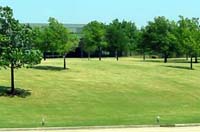


 |
 |
 |
|||
 The following information applies to warm season grasses, such as and hybrid bermuda, centipede, zoysia and St. Augustine. The following information applies to warm season grasses, such as and hybrid bermuda, centipede, zoysia and St. Augustine.Establishing Warm Season Grasses Warm-season grasses can be established with sprigs, sod or by planting seed. Space planting is the planting of separate sprigs at regular intervals. The closer the planting, the more sprigs needed and the faster the coverage. Sprigs should be set 2 inches deep with a portion of the sprig extending above the soil surface. Broadcasting involves spreading a larger quantity of sprigs over the soil surface and then pressing the sprigs into the upper 1 inch of soil by hand or mechanically. Best Time to Plant  March through July is the best time to plant sprigs or lay sod.March through September is the best time to plant seed.Roots of warm-season grasses must have enough time to become established before the weather turns cool. Seeding rates vary from 0.25 to 2.0 pounds per 1000 square feet. March through July is the best time to plant sprigs or lay sod.March through September is the best time to plant seed.Roots of warm-season grasses must have enough time to become established before the weather turns cool. Seeding rates vary from 0.25 to 2.0 pounds per 1000 square feet.Maintaining Warm Season Grasses Warm-season grasses can develop a thatch layer. When the thatch layer is half an inch thick, the lawn should be dethatched or raked. If the lawn becomes compacted, the soil can be aerated in the spring with a device that cuts and removes soil cores. Begin mowing the grass as soon as it is tall enough to be cut. A reel mower is preferred for cutting zoysia, hybrid bermuda and centipede. The suggested cutting height is 1 inch. It is not necessary to collect the clippings unless the amount is excessive and may smother the grass. |
|||
| |||||||||||